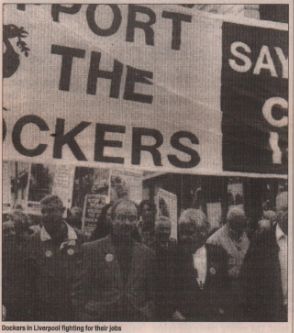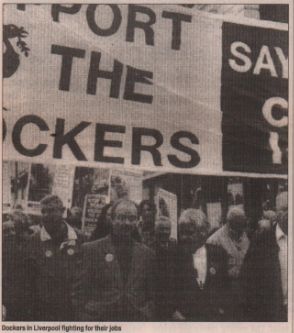
Fight Racism! Fight Imperialism! No 130, April/May 1996
As New Labour has moved ever further to the right in its efforts to court the votes and support of the middle class, debates have started within the left about how it should relate to the working class. Such a debate begs a more fundamental question — what is the working class in Britain? because how you define it decides who you relate to and how. ROBERT CLOUGH discusses the issues.
The prevailing position on the left, shared by the Socialist Workers’ Party (SWP) and the new Socialist Labour Party (SLP), is that the ‘real’ working class are those people organised in the trade union movement. Hence their strategy is to work within the trade union movement, attending branch meetings, conferences and so on. Occasionally there may be strikes, and these become portrayed as the height of working class struggle. Indeed, their answer to any political question such as the struggle against the Poll Tax five years ago, or against the Asylum Bill today, is to make the trade unions the centre of political campaigning.
Yet such a position ignores a substantial change in the trade union movement over the past 15 years. In 1979, total trade union membership was over 12 million, with more than 10 million in unions affiliated to the TUC. Now membership is about 7.1 million — 33 per cent of those in work, with an estimated 6 million in TUC affiliates. But over half the trade union membership have an A-level qualification or equivalent, and a third a degree or equivalent. As far back as 1991, the Labour Force Survey noted that ‘educated, managerial, professional and associated workers’ were a majority of trade union members. Even where unions have substantial numbers of low paid workers –- Unison, for example — it is the better-off managerial staff who generally run the branches, and whose interests the union protects. Thus it was that the Hillingdon strikers had to occupy Unison offices to secure recognition of their strike.

Will Hutton, in dividing the British population into 30 per cent who are absolutely disadvantaged, 30 per cent who are newly insecure, and 40 per cent advantaged, has no hesitation in placing the majority of trade union members amongst the 40 per cent advantaged. So in orienting towards the trade union movement, organisations such as the SWP look to a relatively affluent and secure section of the population as the potential leadership of a new socialist movement.
So how does Hutton define the 30 per cent disadvantaged and 30 per cent insecure? In the former category he places the unemployed and those who are dependent on state benefits of one kind or another such as the majority of pensioners. In the second category are those who are in employment which is insecure — either part-time or temporary, casual or short-term employment (less than two years). These are workers without any basic employment rights who can be sacked at will, and they include, for instance, 4.9 million part-time workers. He points out that only 35 per cent of the workforce is in tenured, full time employment compared to 55 per cent twenty years ago. Although no socialist, Hutton understands that there have been profound changes in the nature of the working class, even if he himself in the end concludes that progress depends on the affluent 40 per cent.
What then are these changes? In 1964, there were 6.8 million manual workers in the manufacturing sector; today there are less than 3 million. In 1964, there were still nearly 600,000 miners, and just under 400,000 railway workers. Today there are no more than 20,000 miners and less than 120,000 railway workers. The number of construction workers has halved — from 1.65 million to 860,000. Such workers were the foundation of the post-war trade union movement, a movement which was able to thrive in a period of boom when capitalism could grant the mass of the working class secure, full-time employment.
The 1950s and 1960s represented the end of an era when the employed working class was made up of men working in huge concentrations — whether in shipyards or car factories or vast engineering works. This era started with the period of British imperialism’s world domination prior to 1914: in that year, Vickers in Barrow employed over 30,000 in its shipyards, Armstrong 30,000 in its Elswick factory on Tyneside. Although the 1930s saw a shift from heavy to light manufacturing industries, this did not spell the end of these concentrations of workers: two major car factories in Cowley, Oxford employed 30,000 in the early 1970s and over 20,000 worked at Longbridge in Birmingham. In the 1940s, over 40,000 worked the Liverpool docks and 10,000 in the 1970s; now the remaining 500 are on strike in a battle over casualisation.
The fact is that the working class constantly changes with capitalism: or, put another way, capitalism constantly recreates the working class according to its changing requirements. Accumulation, as Marx said; is the independent variable. The first signs of a fundamental reshaping of the British working class came with the end of the post-war boom, when the parasitical nature of British imperialism reasserted itself. The decline in domestic profitability forced British capital to move abroad in search of more favourable investment opportunities. As domestic investment stagnated, employment in manufacturing started to fall. However, political conditions in the 1960s and early 1970s required the maintenance of something near full employment, and this was achieved by expanding employment in unproductive areas such as banking and insurance, in the private sector, or education, health and social services in the state sector. Between 1964 and 1979, employment in banking and insurance rose from 1 to 1.6 million; and from 4.4 million to 6 million in the state sector as a whole. This compensated for the loss of 2.05 million jobs in manufacturing and industry over the corresponding period.
From 1979, these changes accelerated, with the slump of 1981 having a severe impact: 1.8 million jobs in manufacturing and industry disappeared between 1979 and 1983 as unemployment rose to over 3 million. The wholesale attack on trade union and employment rights was a further factor in restructuring the nature of working class employment.

Unproductive forms of labour continued to increase, particularly in the banking sector, which went from 1.62 million to 2.55 million between 1979 and 1992. Underlying this was a steady rise in female employment. In 1964, there were just over 15 million men in work, and just under 8.5 million women. In 1995, there were 10.6 million men and 10.4 million. women. Women make up just half the workforce, but as 4.9 million are part-time workers, they are also those with fewest rights.
Increasingly, then, the employed working class is female, part-time and, if they are not professionals, there is little chance that they will be in a union — at best, one in five, if they are in the manufacturing sector, or just one in ten if they are amongst the 1.5 million part-time workers in distribution, hotels and catering. Compare this with the 2.8 million ‘trade unionists’ amongst 7.3 million professionals, managers and administrators and one can see why trade unionists are heavily represented in Hutton’s top 40 per cent. The position is analogous to that at the turn of the century, when trade unions organised and represented only the upper strata of the working class, and all but excluded the unskilled and casually (or temporarily) employed.
Nor does the resemblance to conditions 100 years ago end there. The difference in earnings between the mass of the working class and the middle class has grown to levels that existed in Victorian times. Between 1979 and 1992, the share of gross disposable earnings of the poorest 60 per cent fell from 42 per cent to 34 per cent. Had the proportions remained the same, the household income of the poorest 20 per cent would be some £3,000 per annum higher. One in three wage earners are on poverty pay (currently assessed at £5.90 per hour). 800,000 women workers earn less than £2.50 per hour. These are the insecure: just under 5.5 million full-time workers, and 4.5 million part-time workers. Of these, nearly 1 million have to hold down more than one job; the prevalence of poverty pay explains why two-thirds of British workers work more than 40 hours per week, and a quarter more than 50 hours. Meanwhile, one in four unemployed men have been thrown on the dole at least five times in ten years; 9 million have had a spell of unemployment since the Tories were elected. And the poorest of all households are those who have no earners at all — 40 per cent in Tyne and Wear, Merseyside, South Yorkshire and Wales.
Black and Asian people continue to be disproportionately represented within these poorer sections of the working class. 83 per cent of Pakistani/Bangladeshi people are in the poorest 40 per cent; 53 per cent of Afro-Caribbeans. Thus it is not surprising that one in three households in the East End of London, where 46 per cent of the population are from ethnic minorities, have an annual income of less than £4,500, and 55 per cent less than £10,000.
In a sense it is misleading to talk of poorer and richer sections of the working class. It obscures the reality: that of the working class being refashioned to meet British capital’s requirement for a workforce cheap enough to make the burgeoning service sector either sufficiently profitable (if it is in private hands) or to constitute a minimal drain on capital’s profits (if it continues to be owned by the state). It is a workforce that needs minimal skills — hence there is less and less need to ensure it is particularly numerate or literate. And because there are so many unemployed, it does not have to be especially healthy either — there are plenty of potential replacements should one fall sick. This in part explains the increasing pressure for selection in education — only the middle class really need more than basic skills — and the steps that are being taken towards a two-tier health service.
The experience of this new working class is then one of exclusion, from education and health services, from trade unions, in fact from all forms of political and social life. Their concerns form no real part of the bourgeois political agenda, whether Tory or New Labour. They are also excluded by those who would regard the trade unions as the primary vehicle for social change or political action. Thus the tiny forces of the British left, whatever they may think of the matter, in reality have no relationship with the working class.




